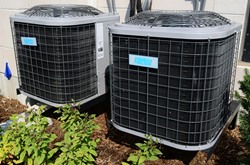How to Find the Right HVAC Program near Big Timber Montana
 Now that you have decided on a career as a heating and cooling technician, the next action is to look for an HVAC vocational school near Big Timber MT. But with so many to pick from, how do you choose the right one to receive the training that you require? A number of potential students will make their selection based entirely on the price of tuition or how near the school is to their residence. Even though these are relevant concerns, they are not the only ones to investigate. A few of the other things that you need to research are the graduation rates of the HVAC schools, their reputations, and if they are accredited by professional trade organizations. Those and other criteria will be discussed in more detail later in this article. But before we examine how to select an HVAC technical school, let’s take a look at what a heating and cooling specialist does to become a licensed professional tradesman.
Now that you have decided on a career as a heating and cooling technician, the next action is to look for an HVAC vocational school near Big Timber MT. But with so many to pick from, how do you choose the right one to receive the training that you require? A number of potential students will make their selection based entirely on the price of tuition or how near the school is to their residence. Even though these are relevant concerns, they are not the only ones to investigate. A few of the other things that you need to research are the graduation rates of the HVAC schools, their reputations, and if they are accredited by professional trade organizations. Those and other criteria will be discussed in more detail later in this article. But before we examine how to select an HVAC technical school, let’s take a look at what a heating and cooling specialist does to become a licensed professional tradesman.
How to Become an HVAC Specialist
 HVAC is an acronym that is frequently used in the industry that stands for “Heating, Ventilation and Air Conditioning”. HVAC professionals provide services for the installation, repair and maintenance of air conditioners, furnaces, boilers, water heaters and heating systems. As professional tradesmen, they are generally mandated to be licensed, although each state and regional municipality has its own requirements. Attaining professional certification is not compulsory, but an alternative way for Big Timber MT HVAC specialists to prove that they are exceptionally skilled and experienced in their area of specialization. There are many acknowledged certifications within the trade that are offered. Following are some of the important ones.
HVAC is an acronym that is frequently used in the industry that stands for “Heating, Ventilation and Air Conditioning”. HVAC professionals provide services for the installation, repair and maintenance of air conditioners, furnaces, boilers, water heaters and heating systems. As professional tradesmen, they are generally mandated to be licensed, although each state and regional municipality has its own requirements. Attaining professional certification is not compulsory, but an alternative way for Big Timber MT HVAC specialists to prove that they are exceptionally skilled and experienced in their area of specialization. There are many acknowledged certifications within the trade that are offered. Following are some of the important ones.
- North American Technician Excellence (NATE). NATE is a nationally acknowledged certification for HVAC technicians. The certification is attained by passing a competency examination and can be received in one or more specialties.
- HVAC Excellence. This certification offers both a professional and a master specialist credential. Two years of professional experience in addition to passing a comprehensive exam are needed for the professional level certification. Master specialists need to have three years of experience in addition to a passing result on the professional level exam. Similar to NATE, certifications are provided in several specialties.
- EPA Section 608. This certification is mandatory for technicians that handle refrigerants. There are three types of certification available, one for small appliances, and the additional two for low and high pressure refrigerants.
Because licensing could be required in your area, and you may also wish to earn certification, it’s imperative that you choose an HVAC technical school that will prepare you for both. And since you will probably be dealing with refrigerants, make sure that the program you decide on readies you for passing the EPA Section 608 exams.
HVAC Degree and Certificate Courses
 There are a number of choices offered for HVAC training in a technical or vocational school. You can attain a certificate, an Associate Degree, or a Bachelor’s Degree. Acquiring a certificate will take the minimum period of time, usually achieved in just six months, however some programs are longer. A certificate will qualify you for the majority of HVAC positions, especially if you are licensed and have certification relevant to the position. The degree programs might provide a competitive edge in the job market and will furnish more comprehensive training than the certificate programs. Following is a short summary of each option offered near Big Timber MT.
There are a number of choices offered for HVAC training in a technical or vocational school. You can attain a certificate, an Associate Degree, or a Bachelor’s Degree. Acquiring a certificate will take the minimum period of time, usually achieved in just six months, however some programs are longer. A certificate will qualify you for the majority of HVAC positions, especially if you are licensed and have certification relevant to the position. The degree programs might provide a competitive edge in the job market and will furnish more comprehensive training than the certificate programs. Following is a short summary of each option offered near Big Timber MT.
- Certificate. Normally requiring a high school diploma, certificate programs are preferred among entry level residential or commercial HVAC technicians. They furnish a solid foundation of skills for job opportunities within the industry.
- Associate Degree. The Associate Degree in HVAC program supplies a more exhaustive knowledge of heating and cooling systems than the certificate program. Generally taking two years to complete, some degrees incorporate an internship or work-study program.
- Bachelor’s Degree. The Bachelor’s Degree in HVAC is suited more towards a career in management as well as business ownership. Some programs call for an Associate Degree, while others are a conventional four year program. In addition to learning how to service and maintain heating and cooling systems, you will also learn how to design them.
Picking the ideal credential program will be dependent on what your future career aspirations are, in addition to the time and financial resources that you have to commit. One approach is to begin with a certificate or even an Associate Degree program, and after gaining some experience in the field in Big Timber MT, eventually returning to earn a Bachelor’s Degree. If this is your approach, be sure to ask the HVAC tech school you are looking at about how their returning student program works.
HVAC Classes Online
 Enrolling in an HVAC program online is one alternative to getting your training and earning a certificate or degree. Nearly all schools will call for some attendance on campus to participate in practical training. A number also sponsor internship or work-study programs in addition to or as an alternative to practical lab work. But since the balance of the classes may be attended on the web, this approach may be a more accessible solution for some Big Timber MT students that are short on time. And a number of online degree programs are less expensive than other on campus alternatives. Even commuting expenses from Big Timber and study materials can be lessened, helping to make education more affordable. And numerous online programs are fully accredited (more on this later). So if your job or family obligations have left you with minimal time to attend classes, maybe an HVAC online training program will make it easier to fit school into your busy lifestyle.
Enrolling in an HVAC program online is one alternative to getting your training and earning a certificate or degree. Nearly all schools will call for some attendance on campus to participate in practical training. A number also sponsor internship or work-study programs in addition to or as an alternative to practical lab work. But since the balance of the classes may be attended on the web, this approach may be a more accessible solution for some Big Timber MT students that are short on time. And a number of online degree programs are less expensive than other on campus alternatives. Even commuting expenses from Big Timber and study materials can be lessened, helping to make education more affordable. And numerous online programs are fully accredited (more on this later). So if your job or family obligations have left you with minimal time to attend classes, maybe an HVAC online training program will make it easier to fit school into your busy lifestyle.
Questions to Ask HVAC Training Programs
 After you have decided on the type of certificate or degree that you would like to acquire, either online or on campus, you can begin to decrease your list of schools. As you are probably aware, there are numerous HVAC vocational schools in the Big Timber MT area and across the United States to choose from. That’s why it is very important to have a checklist of important qualifications when making school comparisons. As formerly mentioned in our opening paragraph, tuition and location will undoubtedly be the initial 2 variables you will take into consideration. Following are some additional ones that you need to research before enrolling in your school of choice.
After you have decided on the type of certificate or degree that you would like to acquire, either online or on campus, you can begin to decrease your list of schools. As you are probably aware, there are numerous HVAC vocational schools in the Big Timber MT area and across the United States to choose from. That’s why it is very important to have a checklist of important qualifications when making school comparisons. As formerly mentioned in our opening paragraph, tuition and location will undoubtedly be the initial 2 variables you will take into consideration. Following are some additional ones that you need to research before enrolling in your school of choice.
Accreditation. Numerous HVAC technical programs in the Big Timber MT area have attained either a regional or a national accreditation. They can receive Institutional Accreditation, which focuses on the school’s programs overall, or Programmatic Accreditation, which relates to an individual program, such as HVAC technology. Confirm that the program is accredited by a U.S. Department of Education approved accrediting agency, for instance the Accreditation Board for Engineering and Technology. Along with helping ensure that you obtain an excellent education, it can help in securing financial assistance or student loans, which are frequently not available for non-accredited programs. Furthermore, a number of states require that the HVAC training course be accredited for it to qualify for licensing.
High Completion Rates. Ask the HVAC schools you are considering what their completion rates are. The completion rate is the percentage of students who enroll in and complete the course. A low completion rate might indicate that students were dissatisfied with the course and dropped out. It may also signify that the teachers were not competent to instruct the students. It’s also essential that the schools have higher job placement rates. Older and/or more reputable schools may have a more extensive directory of alumni, which can produce more contacts for the school to employ for their apprenticeship and job placement programs. A high job placement rate can not only confirm that the school has a good reputation within the field, but additionally that it has the network of Big Timber MT HVAC employers to assist students obtain apprenticeships or employment.
Apprenticeship Programs. Most HVAC technical programs are taught together with an internship or an apprenticeship program. Those participating trade and vocational schools will help place you in an apprenticeship program within their network of Heating and Cooling contractors or trade unions. Find out if the schools you are comparing have referring relationships with local Big Timber MT HVAC companies. An apprenticeship not only offers a rewarding experience by providing practical training, but it also provides employment opportunities and helps to establish relationships in the area HVAC professional community.
Modern Facilities. Make certain that the campus facilities and the tools that you will be trained on are state-of-the-art and what you will be using on the job. If you are presently in an internship or an apprenticeship, talk to the HVAC specialist you are working under concerning what you should be expecting. Otherwise, ask a local Big Timber MT HVAC company if they can provide some pointers. Additionally bear in mind that unless you can move, the school needs to be within commuting distance of your Big Timber MT home. Remember that if you decide to enroll in an out-of-state school, in addition to moving costs there might be higher tuition fees compared to in-state residents.
Smaller Classes. It’s important that you get as much personalized instruction as possible, which can be challenging in bigger classes. Ask if you can sit in on a few of the classes so that you can see how large they are and experience the interaction between students and teachers. Talk with several of the students and get their feedback regarding class sizes and instruction. Last, speak to a few of the teachers and learn what their level of expertise is and what certifications or degrees they have earned.
Flexible Scheduling. Verify that the class schedules for the programs you are reviewing are flexible enough to handle your needs. If you can only go to classes at night or on weekends near Big Timber MT, check that the programs you are reviewing provide those choices. If you can only attend part-time, make sure that the school you select permits part-time enrollment. Additionally, ask what the protocol is to make-up classes should you miss any because of work, sickness or family responsibilities.
Considering an HVAC School near Big Timber MT?
Perhaps you are considering enrolling in an HVAC training program in the Big Timber Montana area. If so, you may find the following background information about the location of your new school campus both interesting and informative.
Big Timber, Montana
Big Timber takes its name from Big Timber Creek, which was named by William Clark because of the large cottonwood trees.[5] The post office was established in 1880, closed, then reopened in 1882 with Ella Burns as postmaster.[6] As a stop on the Northern Pacific Railroad, Big Timber became a major wool-shipping depot. It became the county seat in 1895.[7] A fire in 1908 destroyed half the commercial buildings and a third of the residential homes.[7]
Big Timber has a cool semi-arid climate (Köppen BSk) bordering on a humid continental climate (Dfb). Although winters can be frigid, frequent chinook winds will raise temperatures above 50 °F or 10 °C on an average twenty days between December and February, and have raised them to or above 68 °F or 20 °C on ten occasions during these months since 1894.[9] The chinooks mean Big Timber's 31.3 days per year failing to top freezing is among the fewest in Montana, with the average window for such maxima being from November 11 to March 18.[9] In the absence of chinooks, temperatures fall to 0 °F or −17.8 °C on seventeen mornings during an average winter, although such temperatures were reached just once in 1999/2000 but as many as thirty-four times during the very cold winters of 1935/1936 and 1978/1979. The average window for zero temperatures is from December 4 to February 25. The coldest temperature in Big Timber has been −47 °F (−43.9 °C) during the notorious 1936 cold wave on February 15, whilst February 1936 was also the coldest month on record at 5.0 °F or −15.0 °C, shading January 1916 which averaged 5.5 °F or −14.7 °C.
Spring is typically windy with temperatures nearly so variable as in winter: the last frost typically arrives on May 19, but temperatures have reached 80 °F or 26.7 °C as early as March 22 of 1928 and have fallen to zero Fahrenheit as late as April 13, 1928 and April 12, 1997. Late in spring thunderstorms increase in frequency and during late spring and early summer these provide most of Big Timber's annual precipitation. The wettest calendar year since 1894 has been 1957 with 25.71 inches (653.0 mm) and the driest 1939 with 9.38 inches (238.3 mm), whilst the wettest single month has been May 1981 with 7.69 inches (195.3 mm)
HVAC Course Cost Big Timber MT
Picking the right HVAC school program is an important beginning toward a rewarding career in the heating & cooling industry. You originally came to this website because you wanted more information regarding HVAC Course Cost. However, as we have covered in this post, you should select an Heating and Cooling vocational school and a degree or certificate program that are both accredited and have excellent reputations within the HVAC profession. Other factors to search for are sufficient practical training and modern facilities. You need to visit each of the schools personally that you are most interested in to inspect the campus and speak with both the current students and faculty. Try to get a feel for the quality of the training and the interaction between them. Additionally, inquire about scheduling options and whether night or weekend classes are available if needed. And don’t forget to inquire about financial aid and student loan options as well. If you ask the appropriate questions as we have laid out in our checklist for evaluating schools, you’ll be able to filter your choices so that you can make an educated decision. With the right training, hard work and commitment, you can eventually become a licensed HVAC contractor in Big Timber MT.
More Hot and Cool Locations in Montana
Business Results 1 - 10 of 3






